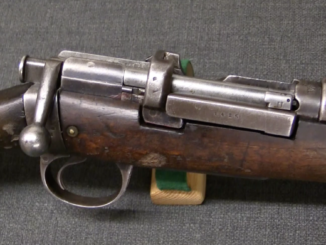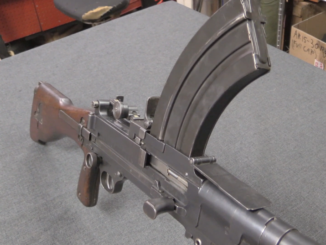Today, courtesy of Mike Carrick from Arms Heritage magazine, we are taking a look at a quite old Indian matchlock “toradar”. Not just any matchlock, but one with a 4-shot revolving cylinder. Matchlocks appeared in India in the 1500s, and repeating ones like this appeared by the 1600s – firearms development was not the exclusive domain of Europe. This particular example shows influences from both east and west, with a typically Asian forward-moving match and a stock resembling an Afghan jezail.
Related Articles

Bolt Action Rifles
Turkish “Enfauser” – Mauser/Enfield Hybrid Rifle

Bolt Action Rifles


I wonder if that was a shotgun. That would make a start at explaining the long chambers.
If you notice the taper in each chamber, my guess is that the powder fills the tapered section, with the ball tamped way down the chamber tube on top. With half the chamber tube empty, perhaps this is a safety feature to prevent multiple-chamber discharge (I have heard the term “hangfire” used but I think that’s wrong). Of course a forty-inch barrel seems long for a shotgun but considering the smooth bore and primitive sights perhaps your guess might be right.
Which leads me to the thought — perhaps it was a punt gun for shooting up into large flocks of birds. Four shots quick would bring home a lot of dinners.
It might be using as a forearm holding there… For protecting against cylinder barrel split… Perhaps…
I thought the same – wide, palm-filling cylinder acting as the foregrip, putting chainfires (or even routine forcing-cone spitting) past the shooter’s hand.
On my first glance at the photo I missed the main barrel and thought it might be a pepperbox carbine – maybe not the most efficient way to burn blackpowder, but still a pretty sweet close-in weapon for those days.
I thinking along the same lines . Long barrel,smooth bore and only a bead sight. Something like a Fowler.
Reading Lt James Forsyth’s “the sporting rifle and its projectiles” written in the 1800s.He gives insight into the local Indian matchlocks. Seems they were typically smoothbore like other muskets and primarily using a round ball but with a very substantial charge of powder giving them high velocity, flat trajectory and good penetration and killing power on dangerous bigger animals.
He’s sufficiently influenced by them to recommend against slower conical projectiles in hunting rifles in favour of round balls with very slow twist rifling driven at around 1800-2000fps which apparently didn’t require sight adjustment or holdover out to 150yards.
He was hunting tigers and large herbivores much like the locals would, on foot and really saw a need for guns that drive the projectile straight through bone, muscle and organs that didn’t require holdover.
I’m very interested in the persistence and diversity of matchlocks, especially in Asia. There were serve kinds and styles and they remained in used into the 20th century. There were as well snap and steady firing mechanisms and lots and lots of style. To be sure matchlock technology was “simple” but it really hung on in Asia, but not in the New World or East Africa. I think we may be underplaying some of it potential advantages.
@peter bleed i think you’re right about under appreciated advantages. Especially for their context. Advantages i see are the instant ignition (matchlocks apparently are faster than flintlicks) and also economic ones. There’s less need for trade items of specific sizes and configurations like primers or flints. for that matter. Certainly cartridge firearms are heavily supply chain reliant.
The barrel seems to be drooping, perhaps due to bending at the revolver/barrel interface; if corrected, the sights may align as intended.
Gunpowder burns quickly, dynamite detonates. (Of course gunpowder can detonate if loaded incorrectly with open space allowed within the chamber. The pressure curve for burning powder is relatively flat and smooth compared with the pressure curve of a detonation which is short and almost vertical.)
If that long barrel was damaged or not desired, you could (with maybe a little help from the Huzoor’s gunsmith) remove it and have a neat 4-shot carbine, as suggested above. (Devising an alternate spring clip would be no problem for Northwest Frontier tinkerers.) Also, note that reloading each short chamber would be much easier than ramming a charge down a barrel that long.
A remarkably simple, but functional-effective design.
Of ‘possible interest’ is several written references that I have come across to one of the reasons that matchlocks lingered in India being the lack of suitable stone in India to use as flints – which consequently all had to be imported. This seems ‘interesting’, but I am not knowledgeable enough to have more than a layman’s opinion on.
Would the spacing and depth of the chambers have anything to do with the grade of metallurgy and prevention of chain fire?
An interesting idea about using it as a pistol with the barrel removed. Sounds logical.
Long barrels is needed for low quality gunpowder. Many primitive shotguns had long barrels for this very reason, rather than for accuracy.
Match locks are still used in backward regions solely because of their simplicity and cheapness; all that is needed for a shot is a shell and gunpowder. The projectile can be any piece of metal or stone that will fit through the barrel. And gunpowder can be made with only an old barn, a boiler and wood.
About metallurgy and chainfire, it’s also plausible.
The level of the then Indian metallurgy is well known. “Go to the British and steal some pieces of iron from them.” 😉
As well as “chain fire” if you charge the device at random.
There is no “traditional hunting weapon” among the Hindus. They are predominantly vegan.
Does that load all the way from the muzzle?
Since the front of at least one chamber in the cylinder is clear of the frame, I’m not sure why anyone would go through all that.
If you notice the taper in each chamber, my guess is that the powder fills the tapered section, with the ball tamped way down the chamber tube on top. With half the chamber tube empty, perhaps this is a safety feature to prevent multiple-chamber discharge (I have heard the term “hangfire” used but I think that’s wrong). Of course a forty-inch barrel seems long for a shotgun but considering the smooth bore and primitive sights perhaps your guess might be right.
Which leads me to the thought — perhaps it was a punt gun for shooting up into large flocks of birds. Four shots quick would bring home a lot of dinners.
If you notice the taper in each chamber, my guess is that the powder fills the tapered section, with the ball tamped way down the chamber tube on top. With half the chamber tube empty, perhaps this is a safety feature to prevent multiple-chamber discharge (I have heard the term “hangfire” used but I think that’s wrong). Of course a forty-inch barrel seems long for a shotgun but considering the smooth bore and primitive sights perhaps your guess might be right. https://www.google.com/
Which leads me to the thought — perhaps it was a punt gun for shooting up into large flocks of birds. Four shots quick would bring home a lot of dinners.
If you notice the taper in each chamber, my guess is that the powder fills the tapered section, with the ball tamped way down the chamber tube on top. With half the chamber tube empty, perhaps this is a safety feature to prevent multiple-chamber discharge (I have heard the term “hangfire” write my papers for cheap I think that’s wrong). Of course a forty-inch barrel seems long for a shotgun but considering the smooth bore and primitive sights perhaps your guess might be right.
Read a short first-person account years ago from an East Indian Tiger Hunter stalking a Bengal with a Matchlock. He went on about his worry that the match would go out! Crazy.
Lieutenant James Forsyth, in his book Sporting Rifle and Shells, provides an insight into the local Indian wick locks. They seemed to be usually smooth-bore like other muskets, and mostly used a round ball, but with a very significant charge of gunpowder, which gave them high speed, flat trajectory and good penetration and stopping power on dangerous larger animals. tigers and large herbivores, and really saw the need for weapons that had high lethality and good penetration. I recommend watching videos with reviews of this book on YouTube, I found a dozen of these videos there and they all had at least a hundred thousand views! I am sure their authors used the services of https://soclikes.com/ in order to wind up views.
Thanks for sharing it